
American postcard by Pomegranate Publications, Petaluma, CA, no. 5314, 1989. Photo: The Avery Collection. John Huston in Man in the Wilderness (Richard C. Sarafian, 1971).

Chinese postcard by Laverton. Photo: Elliott Erwitt/Magnum Photos. John Huston on the set of The Misfits (John Huston, 1961) with his stars Montgomery Clift, Marilyn Monroe, Clark Gable, Eli Wallach, producer Frank E. Taylor and writer Arthur Miller.
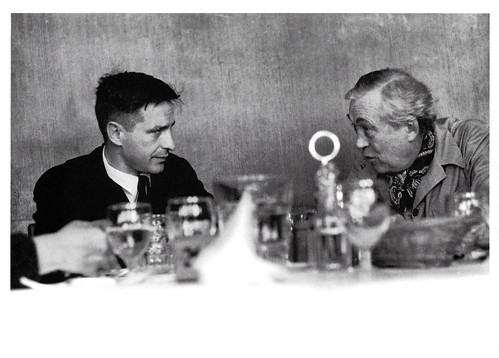
Swiss-British-German postcard by News Productions, Baulmes and Stroud / Filmwelt Berlin, Bakede, no. 56569, 1994. Photo: Larry Shaw. Caption: John Cassavetes and John Huston, Pinewood Studios, England, 1967.
One of the greatest detective films ever made
John Marcellus Huston was born in Nevada, Missouri, in 1906. The age-old story goes that the small town of his birth was won by John's grandfather in a poker game. However, he was raised in Weatherford, Texas, until his family moved to Los Angeles, California. John's father was the character actor Walter Huston, and his mother, Rhea Gore, was a newspaperwoman who travelled around the country looking for stories. The only child of the couple, John began performing on stage with his vaudevillian father at age 3. Upon his parents' divorce at age 7, the young boy would take turns travelling around the vaudeville circuit with his father and the country with his mother on reporting excursions. A frail and sickly child, he was once placed in a sanitarium due to both an enlarged heart and kidney ailment. Making a miraculous recovery, he quit school at age 14 to become a full-fledged boxer and eventually won the Amateur Lightweight Boxing Championship of California.
John married his high school sweetheart, Dorothy Harvey, and in 1925, he also made his stage debut with a leading role off-Broadway in the play 'The Triumph of the Egg'. He made his Broadway debut that same year with 'Ruint' (1925) and followed that with another Broadway show 'Adam Solitaire' (1925). John soon grew restless with the confines of both his marriage and acting and abandoned both, taking a sojourn to Mexico where he became an officer in the cavalry and expert horseman while writing plays on the sly. Trying to control his wanderlust urges, he subsequently returned to America and attempted newspaper and magazine reporting work in New York by submitting short stories. He was even hired at one point by mogul Samuel Goldwyn Jr. as a screenwriter, but again he grew restless. During this time he also appeared unbilled in a few obligatory films. By 1932 John was on the move again and left for London and Paris where he studied painting and sketching. The promising artist became a homeless beggar during one harrowing point.
Returning again to America in 1933, he played the title role in a production of 'Abraham Lincoln', only a few years after his father Walter portrayed the part on film for D.W. Griffith. John began to collaborate on a few scripts for Warner Brothers. He also married again. Warners was so impressed with his talents that he was signed on as both screenwriter and director for the Dashiell Hammett hardboiled mystery The Maltese Falcon (John Huston, 1941). This film classic made a superstar out of Humphrey Bogart and is considered by critics as one of the greatest detective films ever made. In the meantime, John wrote and staged a couple of Broadway plays. After his successful film debut, he directed bad-girl Bette Davis and good girl Olivia de Havilland in the melodrama In This Our Life (John Huston, 1942). He then reunited with three of the stars of The Maltese Falcon, Humphrey Bogart, Mary Astor and Sydney Greenstreet in the romantic war picture Across the Pacific (John Huston, Vincent Sherman, 1942).
During World War II, John Huston served as a Signal Corps lieutenant and went on to helm a number of film documentaries for the U.S. government including the controversial Let There Be Light (1941) about Post-Traumatic Stress Disorder (PTSD), or 'shell shock', for which he followed a group of mentally traumatized veteran patients as they go through psychiatric treatment. His father Walter narrated the film. This film was banned for 35 years because the American government thought it was unsuitable for audiences, and it was shown for the first time at the Cannes festival in 1981. The end of WWII also saw the end of his second marriage with Edith Lesley Black (1937-1945).
The impulsive and unpredictable Huston married his third wife, actress Evelyn Keyes, in 1946 but this marriage also lasted a relatively short time. That same year Huston directed Jean-Paul Sartre's experimental play 'No Exit' on Broadway. The show was a box-office bust and ran less than a month but it nevertheless earned the New York Drama Critics Award as 'best foreign play'. Hollywood glory came to him again in association with Bogart and Warner Brothers. The Treasure of the Sierra Madre (John Huston, 1948) became a classic tale of gold, greed and man's inhumanity to man set in Mexico. John won Oscars for both director and screenplay and his father Walter received the Best Supporting Actor award. John can be glimpsed at the beginning of the film in a cameo playing a tourist, but he wouldn't act again on film for a decade and a half.
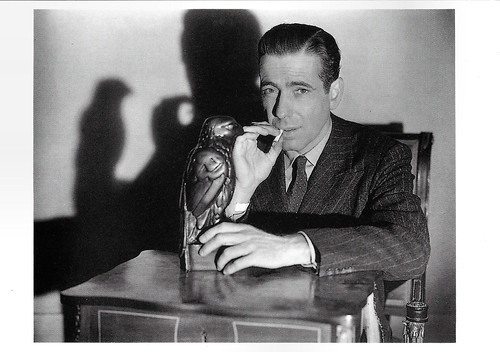
Swiss-German-British postcard by News Productions, Baulmes / Filmwelt Berlin, Bakede / News Productions, Stroud, no. 56495. Photo: Warner Bros / Collection Cinémathèque Suisse, Lausanne. Humphrey Bogart in The Maltese Falcon (John Huston, 1941).
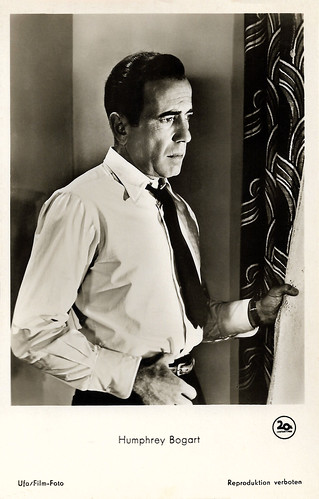
German postcard by UFA/Film-Foto, Berlin-Tempelhof, no. FK 305. Photo: 20th Century Fox. Humphrey Bogart in The Maltese Falcon (John Huston, 1941).

French postcard in the Entr'acte series by Éditions Asphodèle, Mâcon, no. 004/13. Photo: Collection B. Courtel / D.R. Humphrey Bogart and Edward G. Robinson on the set of Key Largo (John Huston, 1948). Caption: Ouch! My ears! Wouldn't Humphrey Bogart appreciate the efforts of his partner Edward G. Robinson in recording a song?

Belgian postcard by Nieuwe Merksemsche Chocolaterie S.P.R.L., Merksem Anvers, no. D7. Photo: Columbia. Jennifer Jones in We Were Strangers (John Huston, 1949). Collection: Marlene Pilaete.
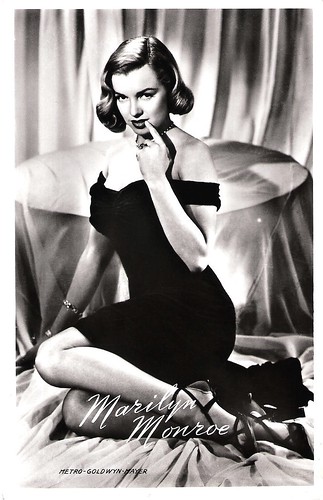
Dutch postcard by Uitg. Takken, Utrecht, no. 1708. Photo: Eric Carpenter / Metro-Goldwyn-Mayer. Marilyn Monroe in The Asphalt Jungle (John Huston, 1950).
Some of the finest American films of that period
In the following decade, John Huston wrote and directed write and/or direct some of the finest American films of that period including Key Largo (1948) and The African Queen (1951) both with Humphrey Bogart, the Film Noir The Asphalt Jungle (John Huston, 1950), the war film The Red Badge of Courage (John Huston, 1951) with Audie Murphy and the classic musical Moulin Rouge (John Huston, 1952) starring José Ferrer.
An ardent supporter of human rights, he, along with director William Wyler and others, dared to form the Committee for the First Amendment in 1947, which strove to undermine the House Un-American Activities Committee. Disgusted by the Hollywood blacklisting that was killing the careers of many talented colleagues, he moved to St. Clerans in Ireland and became a citizen there along with his fourth wife, Russian prima ballerina Enrica (Ricki) Soma. The couple had two children, son Tony Huston (1950) and daughter Anjelica Huston (1951) who went on to have an enviable Hollywood career of her own. Huston and Ricki split after his son, director Danny Huston (1962), was born to actress Zoe Sallis. They did not divorce, however, and remained estranged until her sudden death in 1969 in a car accident. John subsequently adopted his late wife's daughter, Allegra Huston, from another union. The ever-impulsive Huston would move yet again to Mexico where he married (1972) and divorced (1977) his fifth and final wife, Celeste Shane. In his autobiography, published some five years after their divorce, he refused to mention her by name, referring to her only as "a crocodile". On talk shows, he often said it was the only one of his marriages he regretted.
His later films included Moby Dick (John Huston, 1956) based on the classic story by Herman Melville about Captain Ahab (Gregory Peck) and his obsession with a huge whale, Moby Dick, The Unforgiven (John Huston, 1960) about a frontier family who is suspected that their adopted daughter (Audrey Hepburn) was stolen from the local Kiowa tribe, and The Misfits (John Huston, 1961) the last completed film for both Clark Gable and Marilyn Monroe. The films he made in the 1960s also included Freud (John Huston, 1962) with Montgomery Clift, The Night of the Iguana (John Huston, 1964) starring Richard Burton and Ava Gardner, and The Bible: In the Beginning... (John Huston, 1966) with Michael Parks as Jesus were mostly well-regarded but not close to the level of his earlier revered work. Huston also experimented behind the camera with colour effects and approached such taboo topics as homosexuality and psychoanalysis.
Huston returned to acting auspiciously with a major role in Otto Preminger's epic film The Cardinal (1963) for which Huston received an Oscar nomination at age 57. From that time forward, he would be glimpsed here and there in character roles in both good and bad films that, at the very least, helped finance his own projects. Gary Brumburgh at IMDb: "The former list included outstanding roles in Chinatown (Roman Polanski, 1974) and The Wind and the Lion (John Milius, 1975), while the latter comprised of hammy parts in such awful drek as Candy (Christian Marquand, 1968) and Myra Breckinridge (Michael Sarne, 1970).
Huston directed his daughter Angelica in her film debut, the thoroughly mediocre A Walk with Love and Death (John Huston, 1969), but he made up for it 15 years later by directing her to an Oscar in the gangster film Prizzi's Honor (1985) with Jack Nicholson. In the 1970s Huston resurged as a director of quality films with Fat City (John Huston, 1972) starring Jeff Bridges, The Man Who Would Be King (John Huston, 1975) with Sean Connery and Wise Blood (John Huston, 1979). He ended his career on a high note with Under the Volcano (1984) with Albert Finney, Prizzi's Honor (1985) and the James Joyce adaptation The Dead (John Huston, 1987). His only certifiable misfire during that era was the musical version of Annie (John Huston, 1982), though it was popular among children.
Huston lived the macho, outdoors life, unencumbered by convention or restrictions, and is often compared to Ernest Hemingway and Orson Welles. Gary Brumbrugh: "He was, in fact, the source of inspiration for Clint Eastwood in the helming of the film White Hunter Black Heart (1990) which chronicled the making of The African Queen. Illness robbed Huston of a good portion of his twilight years with chronic emphysema the main culprit. As always, however, he continued to work tirelessly while hooked up to an oxygen machine if need be. At the end, the living legend was shooting an acting cameo in the film Mr. North (1988) for his son Danny, making his directorial bow at the time." While on location, John Huston became seriously ill with pneumonia and died in Middletown, Rhode Island, at the age of 81. He was buried with his mother at Hollywood Memorial Park, now called Hollywood Forever.
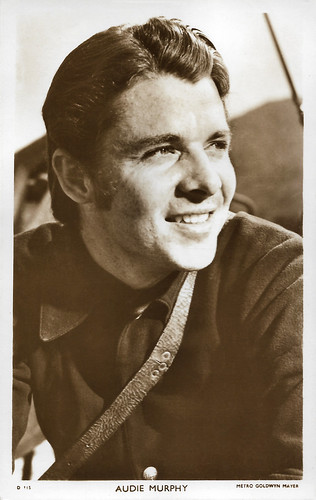
British postcard, in the Picturegoer Series, London, no. D 115. Photo: Metro Goldwyn Mayer. Audie Murphy in The Red Badge of Courage (John Huston, 1951).
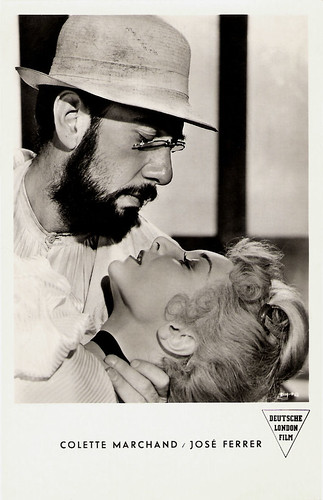
German postcard. Photo: Deutsche London Film. José Ferrer and Colette Marchand in Moulin Rouge (John Huston, 1952).

Czech postcard by Pressfoto, Praha (Prague). Photo: Marilyn Monroe, Clark Gable, and Montgomery Clift in The Misfits (John Huston, 1961). Collection: Carla Bosch.

Dutch collectors card in the series 'Filmsterren: een Portret' by Edito Service, 1994. Photo: The Kobal Collection. Montgomery Clift in Freud (John Huston, 1962).
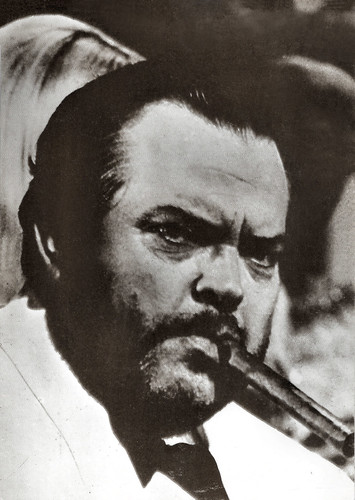
French postcard by Delta Productions, Montpellier, no. CP152. Orson Welles in Casino Royale (Val Guest, Ken Hughes, John Huston, 1967).
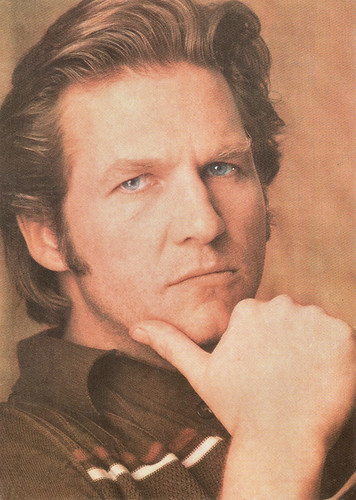
Romanian postcard by Casa Filmului Acin. Jeff Bridges on a publicity still for Fat City (John Huston, 1972).
Sources: Gary Brumburgh (IMDb), Wikipedia and IMDb.
No comments:
Post a Comment